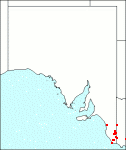|
Crepis vesicaria
Citation:
L., Sp. Pl. 805 (1753) subsp. haenseleri (Boiss. ex DC.) Sell, Bot. J. Linn. Soc. 71:254 (1975).
Synonymy: Barkhausia haenseleri Boiss. ex DC., Prod. 7:153 (1838); C. taraxacifolia Thuill., Fl. Paris 409 (1799); C. vesicaria L. subsp. taraxacifolia (Thuill.)Thell. ex Schinz & R. Keller, Fl. Schweiz 361 (1914); C biennis sensu Jessop, List Vasc. Pl. S. Aust. 17 (1983), non L.
Common name: Dandelion hawksbeard, dandelion crepis.
Description:
Annual or biennial herb 5-70 cm high; stems erect, branched, sparsely hispidulous to glabrous, striate; basal leaves oblanceolate, acute, attenuate at the base, 5-20 cm long, 1.5-5 cm wide, dentate to runcinate-pinnatipartite with denticulate margins, finely scabrous; cauline leaves few, the lowest lanceolate, pinnatisect, amplexicaul with acuminate auricles, those above progressively reduced to filiform bracts c. 1 cm long.
Capitula numerous, on glabrous to hispidulous peduncles 1-12 cm long in a corymbose panicle; involucres 8-12 cm long, 4-7 mm diam.; outer bracts lanceolate, subequal, to half the length of the inner ones, dark, scarious; inner bracts dark-green with pale tomentum, appressed-pubescent on the inner surface; receptacle hairy; florets 25-60; ligules cuneate, 6-8 mm long.
Achenes fusiform, 10-ribbed, 6-8 mm long including a filiform beak 2-3 mm long, scabridulous, brown; pappus bristles 1- or 2-seriate, 4-6 mm long, subequal, white, caducous.
Published illustration:
Ross-Craig (1962) Drawings Brit. Pl. 17:t. 32.
|
|
Distribution:
|
On roadsides and other disturbed sites in forest and scrub.
W.Aust.; N.S.W.; Vic. Native to Europe.
|
Conservation status:
naturalised
Flowering time: Oct. — Nov.
|

SA Distribution Map based
on current data relating to
specimens held in the
State Herbarium of South Australia
|
Biology:
Some collections from the Mt Gambier area have woody rootstocks and markedly hispidulous peduncles, approaching the subspecies stellata (Ball) Babcock.
Author:
Not yet available
|

